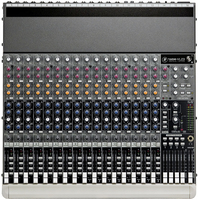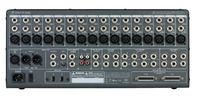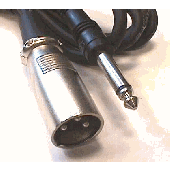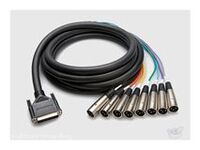 The goal of mixing to multi-track is to be able to record a live production mix along with iso tracks of each major microphone input, so that the audio post production sound editors have the option of using the un-mixed raw mic feeds to reconstruct the soundtrack if the production mix is flawed. However, not all mixing panels can provide the correct direct outs.
The goal of mixing to multi-track is to be able to record a live production mix along with iso tracks of each major microphone input, so that the audio post production sound editors have the option of using the un-mixed raw mic feeds to reconstruct the soundtrack if the production mix is flawed. However, not all mixing panels can provide the correct direct outs.
Mackie Mixing boards are very common on film sets, since they provide excellent quality at very affordable cost. I highly recommend them, and personally own a few of them, which I have used for decades during my professional production sound career. However, there are some limitations when it comes to deriving proper direct outputs from some of these boards.
When you are extracting a direct output from a mixing board, here is what you want to look for.
For starters, the output level should be at line level, rather than mic level. Since the direct out on most boards is post Gain or post Trim, that means that the incoming mic signal has been amplified by the board and is at a nominal line level, so that tends not to be a problem.
The direct out needs to be post Gain, but pre Fader. It serves the post production team limited usefulness if your ISO track mimics your ability to open and close faders during the live production mix. We want the ISO tracks to remain open or hot all the time, regardless of whether you are using that mic feed at the time or not. During the live take, you may be late on opening or closing a mic. It would not make sense for that mistake to be reflected in the ISO track. In addition, you probably have your key actors wearing radio mics, even though most of the action may be boomed. You would want the feed from each radio mic to be recorded at all times, even if you were not using the mic in your production mix at a given moment.
 The Direct Outs featured on the Mackie models 1642 and 1604 are post Fader, not the desired pre Fader. Therefore, you should NOT use these outputs for your ISO tracks.
The Direct Outs featured on the Mackie models 1642 and 1604 are post Fader, not the desired pre Fader. Therefore, you should NOT use these outputs for your ISO tracks.
The model 1620i does not feature any Direct Outs, but does offer 8 Channel Inserts and 4 Aux Sends (selectable for Pre or Post). Keep reading; we will talk about Channel Inserts soon.
 On the model 1640i Mackie Onyx mixer, there are Direct Outs (labeled Recording Out by Mackie) provided by means of a DB25-XLR breakout cable. Actually, there are two of these DB25 connectors: one for inputs 1-8 and a second one for inputs 9-16. The DB25 to (8) XLR-male breakout cable is not included with the Mackie mixer, but has to be purchased or rented separately. HOSA offers a very popular version of this cable for around sixty dollars or so (surf the net for best price). These Direct Outs on the 1640i are post Gain, but pre Fader -- which is what we want to use.
On the model 1640i Mackie Onyx mixer, there are Direct Outs (labeled Recording Out by Mackie) provided by means of a DB25-XLR breakout cable. Actually, there are two of these DB25 connectors: one for inputs 1-8 and a second one for inputs 9-16. The DB25 to (8) XLR-male breakout cable is not included with the Mackie mixer, but has to be purchased or rented separately. HOSA offers a very popular version of this cable for around sixty dollars or so (surf the net for best price). These Direct Outs on the 1640i are post Gain, but pre Fader -- which is what we want to use.
It should be noted that on the older, discontinued original model 1620 Onyx (not to be confunsed with the current 1620i) -- Mackie did in fact provide DB25 connections for Direct Outs. On those early boards, the Firewire was an optional accessory. Many sound mixers believe that Mackie took a giant step backward when they came out with the improved model 1620i, yet dropped the so important Direct Out connection.
Mackie does provide Channel Insert jacks on their line of mixers. These are found on the ever popular model 1402 series (including 1402VLZ, VLZ-Pro, and VLZ3), as well as on the 1620i, 1640i,1642 and 1604 models.
If you read the manual carefully, and pay attention to the Appendix sections -- you will learn that the Channel Insert jacks are multi-faceted in function. If you insert a tip/ring/sleeve insert cable (which is a Y cable with input and output legs), the signal input to the mixer gets interrupted in the flow, and breaks out of the board to go to your signal processor device, and then is re-inserted into the flow. However, if you insert an unbalanced tip/sleeve plug into the jack, then the signal flows out of the board but is not re-inserted. It is a one-way ticket.
Now here is the neat trick. If you only insert the unbalanced tip/sleeve plug into the first notch or first click of the Channel Insert Jack, the input signal is split. One part of the signal exits the board as a post Gain but pre-Fader line output, which becomes your ISO track. But the input signal still remains in the board, and becomes part of the normal mixing flow that is controlled by the Fader.
You must be very careful NOT to insert your plug all of the way into the hole of the jack! Otherwise, you will cut off the signal flow to your Fader and not be able to perform a live production mix.
 The adapter cable that you need is a 1/4-inch mono plug (just a tip and sleeve; no center band) to XLR 3pin male. The tip of the plug is wired to pin 2 of the XLR. The sleeve of the plug is wired to both pins 3 and 1 of the XLR.
The adapter cable that you need is a 1/4-inch mono plug (just a tip and sleeve; no center band) to XLR 3pin male. The tip of the plug is wired to pin 2 of the XLR. The sleeve of the plug is wired to both pins 3 and 1 of the XLR.
In addition to using the Direct Outs (1640i) or the Channel Inserts to provide pre-Fader ISO feeds to your recorder, you can also utilize the pre-Fader Aux Sends. Very often, sound mixers will use a combination of both the Direct Outs along with one or two pre-Fader Aux sends to construct our multi-track assignments.
Consider the situation where you have more mics than tracks! A sound mixer would have the live production mix going out to one track, booms on one or two of the other tracks, maybe a planted mic on yet another, and individual radio mics on the remaining. If there are too many mics, then you need to carefully consolidate some of them. Mics that do not overlap on the timeline could easily share the same ISO track. Or, a group of mics that pose no live mixing problems could be grouped. These consolidated groups of mics can be assigned to a pre-Fader Aux Send, and used for ISO.
In summary
The model 1402 has two Aux Sends. Aux 1 is switchable for pre or post Fader. Aux 2 is post. So, on the 1402, you can use the Channel Inserts and Aux 1 for ISO. In that case, plug your boom duplex cable into Aux 2.
The model 1642 has 4 Aux Sends, with Aux 1-2 being switchable for pre or post Fader, and Aux 3-4 being post only. Direct Outs are post fader, so you would not want to use them. Instead, use the Channel Inserts or Aux 1-2 for your ISO tracks.
The model 1604 has 6 Aux Sends, but only Aux 1-2 are switchable for pre or post Fader. Aux 3-6 are post only. Again, the Direct Outs are post fader, so use the Channel Inserts and Aux 1-2 for your ISO tracks.
The model 1620i does not offer any Direct Outs, but does have Channel Inserts. There are 4 Aux Sends, all of which are switchable for either pre or post fader.
The model 1640i offers real Direct Outs (aka Recording Outs) via a DB25 connection, along with Channel Inserts. There are 6 Aux Sends, all with switches for pre or post fader.
